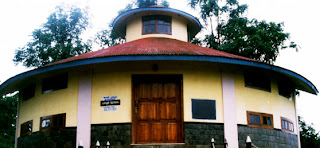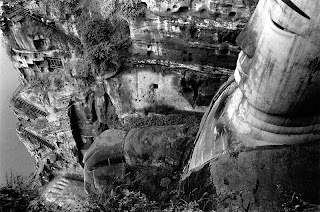Maijishan Grottoes

Maijishan Grottoes in China
History
The Maijishan Grottoes a series of 194 caves cut in the side of the hill of Majishan in Tianshui, Gansu Province, northwest China. This example of rock cut architecture contains over 7,200 Buddhist sculptures and over 1,000 square meters of murals. Construction began in the Later Qin era (384-417 CE).
Maijishan Mountain is placed on the first list of state key scenic spots by its peculiar grottoes, exquisite clay sculptures luxuriant vegetation, all kinds geologies and landforms, mountain peaks. Its main area is 142km2 including Maijishan Grottoes, the Immortal Cliff, the Stone Gate, Quxi Stream and Jieting Hot Spring. Maijishan Grottoes was first built in Later Qin (384-417.D) constructed successively during the 12 dynasties which are West Qin, Northern Wei, West Wei, Northern Zhou, Sui, Tang, Five Dynasty, Song, Yuan, Ming and Qing. Although many earthquakes and conflagration, it still remains 194 caves, 7200 sculpture, 1000 square M fresco which are excatived on the cliff about 30-80m high form the ground, more than 70 percent caves were excavated in the North dynasty. When clay sculpture were popular, well-shaped and excellent art, They reach the climax of sculpture works in early period. Qinling chains in scenic area are the main boundary between North and South nature geography. There are two plant areas, China-Japan, China-Himalayas areas. They include much kind of plants of North China, Central China, and Himalayas.
Menxinduo Higher plant 223 genera, 873 categories, 2738 species, of which bryophyte plant has 53 genera, 98 categories, 138 species, pteridophyte 21 genera, 43 categories, 92 species, angiosperm 141 genera, 712 categories, 2456 species, gymnosperm 8 genera, 20 categories, 48 species. Preserving Xyophyta 20 species including metase quoia, kinkgo, white bark pine etc. the rare key protected plant listed by state has 31 species, (1 level 1 species, 2 level 7 species, 3 level 23 species), forestation coverage reaches 76% wild animal, birds 12 classes, 34 genera, 95 species, beast 6 classes, 18 genera, 29 species, the rare animals protected by state, 6 classes.7 genera, 18 species.
The scenic spots lies in the joint of QiLian-North Qinlin chains. It forms very complicated geologies and landforms due to movement in Yinzi, Yanshan, and Himalayas. Hot Spring and Quxi Stream is metamorphic rock. Maiji Mountain, the lmmortal clitt, is purple red sandstone rock, while the Stone Gate granite. They have different geology and landform in small area, the abundant forest and flower, the stream and waterfall compose of over 180 scenic spots. They show landscape abundance and variety. The reason of protuberant globular valve: The grottoes kept its fine sculpture of 12 feudal dynasties. It possesses large-scale sculpture museum with 1600 years. It provides precious material studding sculpture, painting, arts and crafts, architecture and religion such as Buddhism. The constructed cave in North Wei (408-534A.D) play an important role for its long history in China even in the world, well preserved well shaped, lively figure. There are biggest palace--shaped building in northern dynasties of Chinese grottoes in these 21 grottoes.
Bulding in wall--painting, skill methods and completed methods are both the best important and valuable works. This abundant building material in northern dynasties is the most precious and important illustration in studying grottoes' nationalism, ancient construction, and freseo. There are about 2738 higher vegetation in the scenic spot, of which 60 genus the 3rd Age xylophta 20 genera, the rare vegetation 31 and 18 genera rare animal protected by State. There is such abundant biology in warm temperature Zone of 34 N latitude; its varieties have typical significance. Maijishan Plant is accepted as member by IUCN. Spectacular Maiji peak, exquisite clay carving temple building under cliff, peculiar landform, about plant clear stream and waterfall combine naturally made up a harmonious landscape of mankind and nature.
Winter Palace

Winter Palace, St. Petersburg, Russia
History
From the 1760s onwards the Winter Palace was the main residence of
the Russian Tsars. Magnificently located on the bank of the Neva River,
this Baroque-style palace is perhaps St. Petersburg’s most impressive
attraction. Many visitors also know it as the main building of the
Hermitage Museum. The green-and-white three-storey palace is a marvel of
Baroque architecture and boasts 1,786 doors, 1,945 windows and 1,057
elegantly and lavishly decorated halls and rooms, many of which are open
to the public. The Winter Palace was built between 1754 and 1762 for Empress Elizabeth, the daughter of Peter the Great. Unfortunately, Elizabeth died before the palace’s completion and only Catherine the Great and her successors were able to enjoy the sumptuous interiors of Elizabeth’s home. Many of the palace’s impressive interiors have been remodeled since then, particularly after 1837, when a huge fire destroyed most of the building. Today the Winter Palace, together with four more buildings arranged side by side along the river embankment, houses the extensive collections of the Hermitage. The Hermitage Museum is the largest art gallery in Russia and is among the largest and most respected art museums in the world.
The museum was founded in 1764 when Catherine the Great purchased a collection of 255 paintings from the German city of Berlin. Today, the Hermitage boasts over 2.7 million exhibits and displays a diverse range of art and artifacts from all over the world and from throughout history (from Ancient Egypt to the early 20th century Europe). The Hermitage’s collections include works by Leonardo da Vinci, Michelangelo, Raphael and Titian, a unique collection of Rembrandts and Rubens, many French Impressionist works by Renoir, Cezanne, Manet, Monet and Pissarro, numerous canvasses by Van Gogh, Matisse, Gaugin and several sculptures by Rodin. The collection is both enormous and diverse and is an essential stop for all those interested in art and history. The experts say that if you were to spend a minute looking at each exhibit on display in the Hermitage, you would need 11 years before you’d seen them all. However, we recommend you opt for a guided tour instead!
Buddha Statue in Leshan

Buddha Statue leshan in china
History
The Leshan Giant Buddha (simplified Chinese: Lesha-n Dafo) was built during the Tang Dynasty (618–907AD). It is carved out of a cliff face that lies at the confluence of the Minjiang, Dadu and Qingyi rivers in the southern part of Sichuan province in China, near the city of Leshan. The stone sculpture faces Mount Emei, with the rivers flowing below his feet. It is the largest carved stone Buddha in the world and it is by far the tallest pre-modern statue in the world. The Mount Emei Scenic Area, including Leshan Giant Buddha Scenic Area has been listed
Pazhassiraja Museum


Pazhassiraja Museum Calicut, Kerala
History
Pazhassiraja Museum is beautifully nestled among the picturesque
locations of the district of Calicut (Kozhikode) in Kerala. Calicut city
has become an ultimate destination for the historians and aficionados
of art and literature. Kerala has lured the visitors and traders from
lands far off from time immemorial. Similar was the case of the
Portuguese traveler, who set sails towards India and reached India in
1498 - the name of that sailor was Vasco Da Gama. An art gallery is
located in the vicinity of the museum. The gallery exhibits a number of
paintings of Kerala's respected artists, including the Raja Ravi Varma
and Raja Raja Varma, who were the connoisseurs of painting and other
performing arts. Their paintings, which are preserved artifacts, tell
the tales from the past that were not included in any scripture, the
lore of then modern culture. They also depict the tradition and bounties
from the wars and successions over the neighboring rulers by the ruler
of Kozhikode. Everything is enlisted in visual history of Kerala, which
is summarized into a few oil paintings of these masters.
Pazhassiraja Museum is maintained and preserved by the State Archaeology Department of Kerala. The museum showcases a number of stunning works of art. The ancient coins preserved here can be a delight to look at. Apart from this, the museum also secures traditional bronze sculptures and utensils, umbrella stones, miniature models of temples which are crafted out of plaster of Paris and similar megalithic structures.
There is an interesting story behind the christening of Pazhassiraja Museum. The museum and the art gallery both are named after the great Pazhassiraja of the Padinjare Kovilakom, of the Kottayam regal kin. The much popular 'Pazhassi Revolt', which took place during the British epoch against the British East India Company, was captained by Pazhassiraja. Popularly termed as the Lion of Kerala, Pazhassiraja is the one who is recognized for introducing guerilla warfare in the hills of Wayanad, to resist the British colonialism. The museum seems to be living entity breathing on the cultural heritage, as it assimilates in itself a number of artifacts and items which are a part of Kerala's intellectual heritage. Not just the artifacts but the architecture of the place itself depict the traditional Keralite architecture and hence are preserved as a part of Kerala's cultural heritage
Pazhassiraja Museum is maintained and preserved by the State Archaeology Department of Kerala. The museum showcases a number of stunning works of art. The ancient coins preserved here can be a delight to look at. Apart from this, the museum also secures traditional bronze sculptures and utensils, umbrella stones, miniature models of temples which are crafted out of plaster of Paris and similar megalithic structures.
There is an interesting story behind the christening of Pazhassiraja Museum. The museum and the art gallery both are named after the great Pazhassiraja of the Padinjare Kovilakom, of the Kottayam regal kin. The much popular 'Pazhassi Revolt', which took place during the British epoch against the British East India Company, was captained by Pazhassiraja. Popularly termed as the Lion of Kerala, Pazhassiraja is the one who is recognized for introducing guerilla warfare in the hills of Wayanad, to resist the British colonialism. The museum seems to be living entity breathing on the cultural heritage, as it assimilates in itself a number of artifacts and items which are a part of Kerala's intellectual heritage. Not just the artifacts but the architecture of the place itself depict the traditional Keralite architecture and hence are preserved as a part of Kerala's cultural heritage
Subscribe to:
Comments (Atom)














